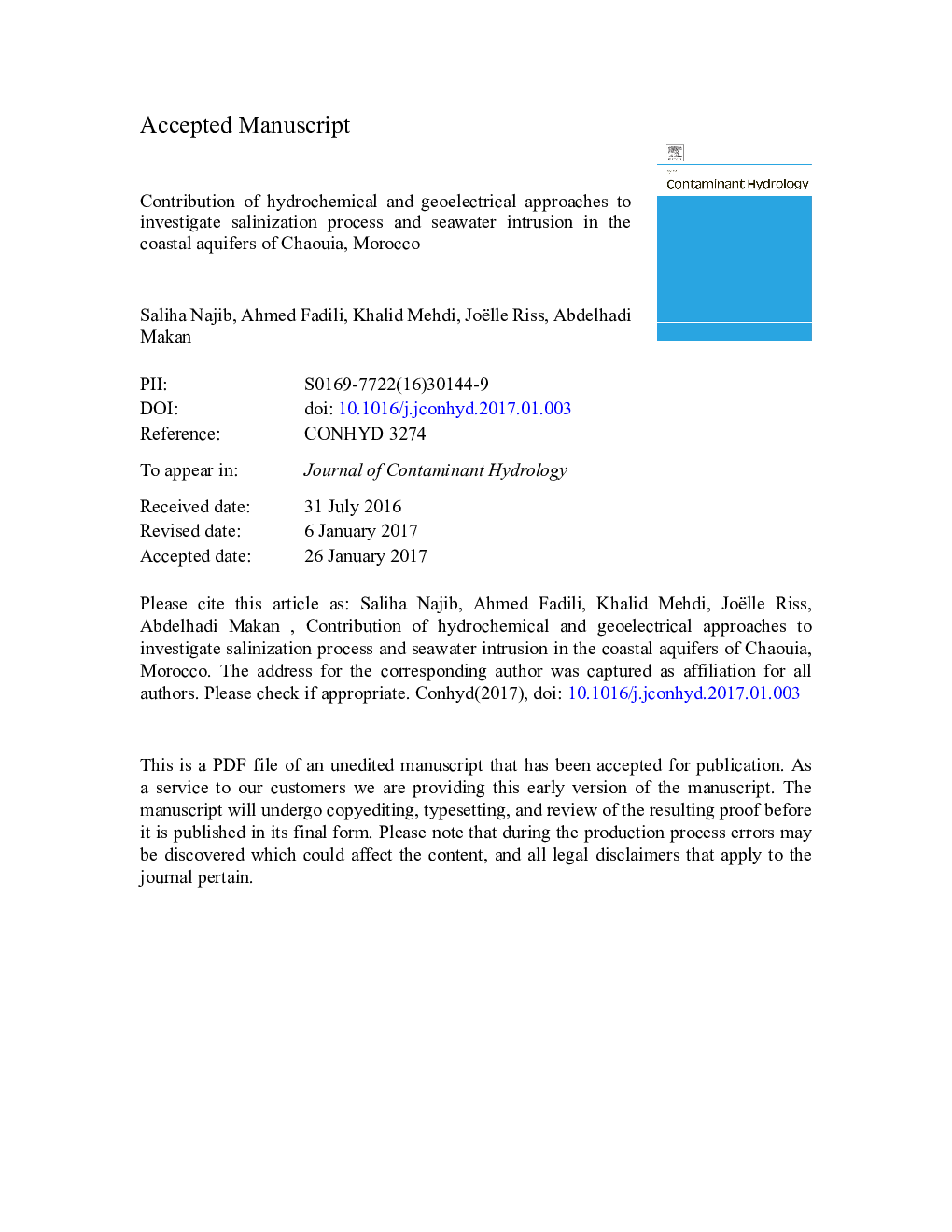| کد مقاله | کد نشریه | سال انتشار | مقاله انگلیسی | نسخه تمام متن |
|---|---|---|---|---|
| 5765935 | 1627013 | 2017 | 41 صفحه PDF | دانلود رایگان |
عنوان انگلیسی مقاله ISI
Contribution of hydrochemical and geoelectrical approaches to investigate salinization process and seawater intrusion in the coastal aquifers of Chaouia, Morocco
دانلود مقاله + سفارش ترجمه
دانلود مقاله ISI انگلیسی
رایگان برای ایرانیان
کلمات کلیدی
موضوعات مرتبط
مهندسی و علوم پایه
علوم زمین و سیارات
فرآیندهای سطح زمین
پیش نمایش صفحه اول مقاله

چکیده انگلیسی
This study aims to identify groundwater salinization origin and to determine seawater intrusion extension toward the inland in Chaouia, Morocco. To reach these objectives, firstly, 46 groundwater samples were analyzed for major chemical elements during January 2012 and, secondly, 10 electrical resistivity tomography (ERT) profiles were performed perpendicularly to the coastal fringe. Statistical analysis provided the distinction between three Clusters reflecting different hydrochemical processes. Cluster I and Cluster II-a showed a high water electrical conductivity (EC) (from 2.3 to 11.2 mS/cm) with the dominance of Na+ (668 mg/L on average) and Clâ (1735 mg/L on average) ions as a consequence of seawater intrusion. However, Cluster II-b presented low ECs (from 0.5 to 1.7 mS/cm) and Ca2 + (99.6 mg/L on average) and HCO32 â (235.2 mg/L on average) ions dominance. Water chemistry in these wells was controlled by water-rock interaction, cation exchange, and anthropogenic activities. The Hydrochemical Facies Evolution Diagram highlighted the succession of different water facies developed between intrusion and freshening phases. The formation of Na-HCO3 facies, which characterizes the last facies of freshening phase, followed the succession of Na-Cl, MixNa-MixCl, MixCa-MixCl, MixCa-MixHCO3, and Na-HCO3. In contrast, Na-Cl facies formation, which characterizes the last facies of intrusion phase, followed the evolution of Ca-HCO3, Ca-MixHCO3, Ca-MixCl, MixCa-MixCl, MixCa-Cl, and Na-Cl. Moreover, the obtained ERT results allowed determining the extent of different hydrochemical facies and provided more details about seawater intrusion extension. The conductive level assigned to seawater contamination showed a resistivity less than 36 Ω.m, which remains limited to 3000 m from the ocean, where Na-Cl water type dominates. The seawater intrusion depth varied between 5 and 40 m from the surface. Overall, this original study in Chaouia region demonstrated the effectiveness of combining hydrochemical and ERT methods to investigate seawater intrusion, particularly in areas with restrictive water chemistry data.
ناشر
Database: Elsevier - ScienceDirect (ساینس دایرکت)
Journal: Journal of Contaminant Hydrology - Volume 198, March 2017, Pages 24-36
Journal: Journal of Contaminant Hydrology - Volume 198, March 2017, Pages 24-36
نویسندگان
Saliha Najib, Ahmed Fadili, Khalid Mehdi, Joëlle Riss, Abdelhadi Makan,